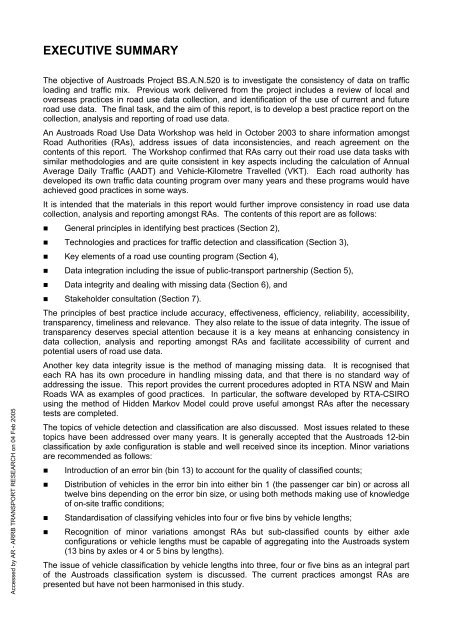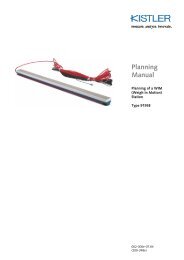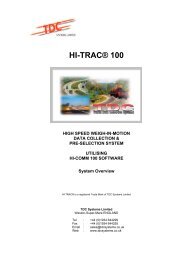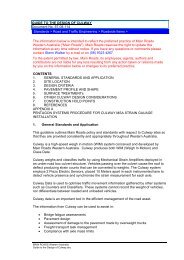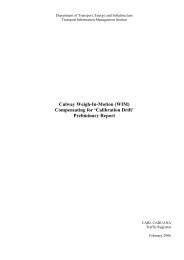AP-G84/04 Best practice in road use data collection, analysis ... - WIM
AP-G84/04 Best practice in road use data collection, analysis ... - WIM
AP-G84/04 Best practice in road use data collection, analysis ... - WIM
You also want an ePaper? Increase the reach of your titles
YUMPU automatically turns print PDFs into web optimized ePapers that Google loves.
Accessed by AR - ARRB TRANSPORT RESEARCH on <strong>04</strong> Feb 2005<br />
EXECUTIVE SUMMARY<br />
The objective of Aust<strong>road</strong>s Project BS.A.N.520 is to <strong>in</strong>vestigate the consistency of <strong>data</strong> on traffic<br />
load<strong>in</strong>g and traffic mix. Previous work delivered from the project <strong>in</strong>cludes a review of local and<br />
overseas <strong>practice</strong>s <strong>in</strong> <strong>road</strong> <strong>use</strong> <strong>data</strong> <strong>collection</strong>, and identification of the <strong>use</strong> of current and future<br />
<strong>road</strong> <strong>use</strong> <strong>data</strong>. The f<strong>in</strong>al task, and the aim of this report, is to develop a best <strong>practice</strong> report on the<br />
<strong>collection</strong>, <strong>analysis</strong> and report<strong>in</strong>g of <strong>road</strong> <strong>use</strong> <strong>data</strong>.<br />
An Aust<strong>road</strong>s Road Use Data Workshop was held <strong>in</strong> October 2003 to share <strong>in</strong>formation amongst<br />
Road Authorities (RAs), address issues of <strong>data</strong> <strong>in</strong>consistencies, and reach agreement on the<br />
contents of this report. The Workshop confirmed that RAs carry out their <strong>road</strong> <strong>use</strong> <strong>data</strong> tasks with<br />
similar methodologies and are quite consistent <strong>in</strong> key aspects <strong>in</strong>clud<strong>in</strong>g the calculation of Annual<br />
Average Daily Traffic (AADT) and Vehicle-Kilometre Travelled (VKT). Each <strong>road</strong> authority has<br />
developed its own traffic <strong>data</strong> count<strong>in</strong>g program over many years and these programs would have<br />
achieved good <strong>practice</strong>s <strong>in</strong> some ways.<br />
It is <strong>in</strong>tended that the materials <strong>in</strong> this report would further improve consistency <strong>in</strong> <strong>road</strong> <strong>use</strong> <strong>data</strong><br />
<strong>collection</strong>, <strong>analysis</strong> and report<strong>in</strong>g amongst RAs. The contents of this report are as follows:<br />
General pr<strong>in</strong>ciples <strong>in</strong> identify<strong>in</strong>g best <strong>practice</strong>s (Section 2),<br />
Technologies and <strong>practice</strong>s for traffic detection and classification (Section 3),<br />
Key elements of a <strong>road</strong> <strong>use</strong> count<strong>in</strong>g program (Section 4),<br />
Data <strong>in</strong>tegration <strong>in</strong>clud<strong>in</strong>g the issue of public-transport partnership (Section 5),<br />
Data <strong>in</strong>tegrity and deal<strong>in</strong>g with miss<strong>in</strong>g <strong>data</strong> (Section 6), and<br />
Stakeholder consultation (Section 7).<br />
The pr<strong>in</strong>ciples of best <strong>practice</strong> <strong>in</strong>clude accuracy, effectiveness, efficiency, reliability, accessibility,<br />
transparency, timel<strong>in</strong>ess and relevance. They also relate to the issue of <strong>data</strong> <strong>in</strong>tegrity. The issue of<br />
transparency deserves special attention beca<strong>use</strong> it is a key means at enhanc<strong>in</strong>g consistency <strong>in</strong><br />
<strong>data</strong> <strong>collection</strong>, <strong>analysis</strong> and report<strong>in</strong>g amongst RAs and facilitate accessibility of current and<br />
potential <strong>use</strong>rs of <strong>road</strong> <strong>use</strong> <strong>data</strong>.<br />
Another key <strong>data</strong> <strong>in</strong>tegrity issue is the method of manag<strong>in</strong>g miss<strong>in</strong>g <strong>data</strong>. It is recognised that<br />
each RA has its own procedure <strong>in</strong> handl<strong>in</strong>g miss<strong>in</strong>g <strong>data</strong>, and that there is no standard way of<br />
address<strong>in</strong>g the issue. This report provides the current procedures adopted <strong>in</strong> RTA NSW and Ma<strong>in</strong><br />
Roads WA as examples of good <strong>practice</strong>s. In particular, the software developed by RTA-CSIRO<br />
us<strong>in</strong>g the method of Hidden Markov Model could prove <strong>use</strong>ful amongst RAs after the necessary<br />
tests are completed.<br />
The topics of vehicle detection and classification are also discussed. Most issues related to these<br />
topics have been addressed over many years. It is generally accepted that the Aust<strong>road</strong>s 12-b<strong>in</strong><br />
classification by axle configuration is stable and well received s<strong>in</strong>ce its <strong>in</strong>ception. M<strong>in</strong>or variations<br />
are recommended as follows:<br />
Introduction of an error b<strong>in</strong> (b<strong>in</strong> 13) to account for the quality of classified counts;<br />
Distribution of vehicles <strong>in</strong> the error b<strong>in</strong> <strong>in</strong>to either b<strong>in</strong> 1 (the passenger car b<strong>in</strong>) or across all<br />
twelve b<strong>in</strong>s depend<strong>in</strong>g on the error b<strong>in</strong> size, or us<strong>in</strong>g both methods mak<strong>in</strong>g <strong>use</strong> of knowledge<br />
of on-site traffic conditions;<br />
Standardisation of classify<strong>in</strong>g vehicles <strong>in</strong>to four or five b<strong>in</strong>s by vehicle lengths;<br />
Recognition of m<strong>in</strong>or variations amongst RAs but sub-classified counts by either axle<br />
configurations or vehicle lengths must be capable of aggregat<strong>in</strong>g <strong>in</strong>to the Aust<strong>road</strong>s system<br />
(13 b<strong>in</strong>s by axles or 4 or 5 b<strong>in</strong>s by lengths).<br />
The issue of vehicle classification by vehicle lengths <strong>in</strong>to three, four or five b<strong>in</strong>s as an <strong>in</strong>tegral part<br />
of the Aust<strong>road</strong>s classification system is discussed. The current <strong>practice</strong>s amongst RAs are<br />
presented but have not been harmonised <strong>in</strong> this study.


